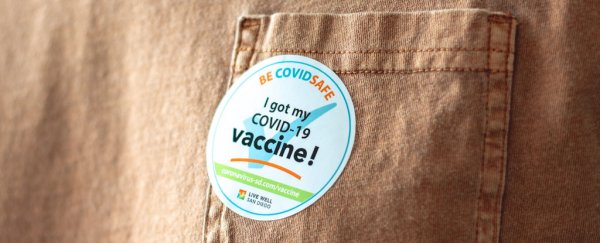After an impressive start vaccination rates in the United States have begun to plateau, even though there's more than enough medicine to go around and a dangerous variant on the loose.
If the nation is to reach President Biden's goal of vaccinating 70 percent of the public, some researchers say we need to start appealing to those who are not just hesitant about vaccines, but apathetic.
Disinterest, they argue, is the latest bump in the road to immunity.
"These might be people who feel very healthy, very strong, [or] think that it's unlikely that they're going to get sick because they live in a low-density area," explain two researchers in a newly published Viewpoint.
"They just don't feel as at risk."
Those who feel apathy towards the COVID-19 vaccine come from a range of backgrounds, researchers say, with different reasons for remaining unvaccinated.
Young people, for instance, might think they are not at risk from COVID-19, so they aren't as bothered about getting vaccinated.
Some older adults, meanwhile, might consider vaccination a low priority compared to all the work and family obligations they are struggling to balance already.
Others might have experienced systemic racism or similar forms of discrimination within the medical system. As such, they are more likely to ignore medical topics, like vaccinations.
It's not that these individuals are actively questioning whether or not to get the COVID-19 vaccine, like those who are hesitant, it's more that they aren't paying attention; getting themselves vaccinated is simply not on their radar.
At the moment it's hard to say how many unvaccinated people currently fall into the apathy group versus the hesitancy group. A lot of the time, the two are lumped together in research.
"Since vaccine hesitancy is receiving a lot of media attention, some individuals may prefer to state their disinterest in getting a vaccine is because of an issue like safety or efficacy, instead of the more personal answer – that they just don't care," says marketing researcher Stacy Wood, one of the authors of the Viewpoint.
In February of 2021, however, a Pew survey did ask more nuanced questions. It found that of all 30 percent of participants who said they probably or definitely wouldn't get the COVID-19 vaccine, nearly half felt as though they didn't need the medicine.
This lines up with more anecdotal reports from around the country. In Mississippi, for instance, vaccines are easily accessible and free, yet a large portion of the public is still not getting the jab.
At this point, the state health officer, Dr Thomas Dobbs, also blamed apathy.
"It's really sad because people in foreign countries would saw off their small toe to get a COVID vaccine, and … we're not gonna take five minutes as we walk by the Kroger pharmacy," Dobbs recently complained in a virtual conversation with the Mississippi Medical Association.
Clearly, health experts need a better way to engage with those who are apathetic about COVID-19. Wood and her coauthor, health care policy expert, Kevin Schulman, think they know how.
Their recent Viewpoint draws on the Elaboration Likelihood Model, which suggests that when someone is less involved in a choice, they aren't as compelled by strong arguments or facts.
"Instead," Wood explains, "it's shown that these individuals are more persuaded by quick, catchy, affective, or big picture appeals."
If this is true, then those who feel apathetic about the COVID-19 vaccine might be better convinced to get the jab with a simple message, one that doesn't contain too much jargon. Maybe it's even delivered by a celebrity or someone loved by the public.
Places like the Ad Council, a non-profit that helps produce public service announcements, recently launched a vaccine campaign in the United States with the slogan: "It's Up to You".

The message is short and has that big picture appeal, but it was also made to speak to those who are already considering the choice of vaccination. What about those who aren't paying attention?
In that case, Wood and Schulman think a marketing approach might work better.
Monetary lotteries and financial incentives, they argue, are really powerful because, as Wood explains in a podcast, "If you're not thinking about getting a vaccine and then there they are at the local baseball game or swimming pool or airport, and they're giving out free pizza and a T-shirt, well, now I'm interested."
That's a good idea in theory, but some states, like Ohio, have tried this already, with little success.
"It's just not working," Irwin Redlener, who directs the Pandemic Resource and Response Initiative at Columbia University, told Politico.
"People aren't buying it. The incentives don't seem to be working – whether it's a doughnut, a car, or a million dollars."
Wood and Schulman might be right in calling for a distinction to be made between vaccine hesitancy and vaccine apathy. But when it comes to communicating with either group, we need far more research to understand how public health experts can best reach out.
The Viewpoint was published in JAMA.
